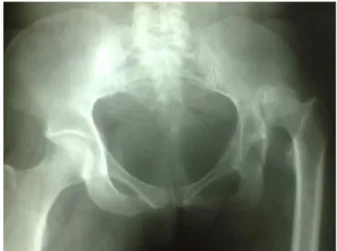w w w . r b o . o r g . b r
Technical
Note
Total
arthroplasty
in
displaced
dysplastic
hips
with
acetabular
reconstruction
and
femoral
shortening
–
technical
note
夽
,
夽夽
Paulo
Silva
a,
Leandro
Alves
de
Oliveira
a,
Danilo
Lopes
Coelho
a,
Rogério
Andrade
do
Amaral
a,
Percival
Rosa
Rebello
a,
Frederico
Barra
de
Moraes
b,∗aHospitalGeraldeGoiânia,Goiânia,GO,Brazil
bClínicadeOrtopediaeTraumatologia,Goiânia,GO,Brazil
a
r
t
i
c
l
e
i
n
f
o
Articlehistory:
Received3April2013 Accepted13May2013
Keywords:
Arthroplasty,replacement,hip Bonediseases,developmental Osteotomy
Transplantation,autologous
a
b
s
t
r
a
c
t
Todescribeanewprocedureoftotalhipreplacementinpatientwithsevere developmen-taldysplasiaofthelefthip,usingtechniqueofacetabularreconstructionwithautogenous bonegraftsandsubtrochantericshorteningfemoralosteotomy.Totalhipreplacementdone inJanuaryof2003.TheEftekhar’sclassificationwasusedandincludedtypeD,neglected dislocations.Bonegraftincorporatedinacetabularshelfandfemoralosteotomy.Our con-tributionistheuseofanAllisplatetobetterfixacetabulargrafts,avoidingloosening,and cerclagearoundbonegraftinfemoralosteotomysite,whichdiminishpseudoarthrosisrisk. Thistechniqueshowsefficiency,allowingimmediatelyresolutionforthiscasewithpainand rangeofmotionofhipimprovement.Italsoallowstheacetabulardysplasiareconstruction, equalizationofthelimblength(withoutelevatedriskofneurovascularlesion)andrepairs thenormalhipbiomechanicsduetothecorrectionofthehip’scenterofrotation.
©2014SociedadeBrasileiradeOrtopediaeTraumatologia.PublishedbyElsevierEditora Ltda.Allrightsreserved.
Artroplastia
total
em
quadris
displásicos
luxados
com
reconstruc¸ão
acetabular
e
encurtamento
femoral
Palavras-chave:
Artroplastiadequadril
Doenc¸asdodesenvolvimentoósseo Osteotomia
Transplanteautólogo
r
e
s
u
m
o
Descrevercontribuic¸õesàtécnicadacirurgiadeartroplastiatotalemdisplasiasdo desen-volvimentodoquadrilgrave,pormeiodareconstruc¸ãoacetabularcomousodeenxerto autólogoeencurtamentofemoralfeitocomosteotomiasubtrocantéricaem Vinvertido. Pacientesubmetidoaartroplastiatotaldoquadrilesquerdoemjaneirode2003.Foiusadaa classificac¸ãodeEftekhareopacienteeradotipoD,luxac¸ãoinveterada.Incorporac¸ãodo enx-ertonotetoacetabulareosteotomiafemoral.Acrescentamosafixac¸ãodoenxertodacabec¸a femoralnoacetábulocomplacadotipoAllis,quecontribuiparamaiorresistênciado sis-tema,eacerclagemcomfiodeac¸onoenxertoósseojuntoàosteotomiasubtrocantérica,que
夽
Pleasecitethisarticleas:SilvaP,deOliveiraLA,CoelhoDL,doAmaralRA,RebelloPR,deMoraesFB.Artroplastiatotalemquadris displ´sicosluxadoscomreconstruc¸ãoacetabulareencurtamentofemoral.RevBrasOrtop.2014;49:69–73.
夽夽
StudyconductedatDepartmentofHipSurgery,HospitalGeraldeGoiânia,ClínicadeOrtopediaeTraumatologiadeGoiânia,GO,Brazil.
∗ Correspondingauthor.
E-mail:fredericobarra@yahoo.com.br(F.B.deMoraes).
2255-4971/$–seefrontmatter©2014SociedadeBrasileiradeOrtopediaeTraumatologia.PublishedbyElsevierEditoraLtda.Allrightsreserved.
tambémareconstruc¸ãododéficitósseoacetabular,arecomposic¸ãodocomprimentodo membro(semriscoaumentadodelesãoneurovascular)earecuperac¸ãodabiomecânicado quadrilcomareparac¸ãodocentroderotac¸ãonormal.
©2014SociedadeBrasileiradeOrtopediaeTraumatologia.PublicadoporElsevier EditoraLtda.Todososdireitosreservados.
Introduction
Sincetheemergenceofthemoderntechniquesofprosthetic reconstruction ofthe hip using the principles ofCharnley etal,1 adiseasecontinuestochallengehip orthopedic sur-geons: developmental dysplasia of the hip (DDH). In DDH the anatomy is altered. The dysplastic acetabulum is ver-tical, shallow and with proximal migration, and has poor bone quality and superolateral coverage deficit. The prox-imal femur is narrow, with small femoral head; and the shortneckand trochanter are locatedposteriorly.Changes inthesoftpartsalsooccur,withflatteningoftheabductor muscles, joint capsule thickening and redundant, hyper-trophy of iliopsoas muscle and shortening of the sciatic nerve.2
Because of these changes, Charnley et al. and Feagin etal.discouragedthepracticeoftotalhiparthroplasty(THA) in patients with DDH.3 Subsequently, other authors have publishedstudiesusing bonegraft,withthegoal of recon-structingtheacetabulum andpromotinganincreaseinthe coverage of the prosthetic component. Hasting et al. and Parkeretal.,4 in1975,werethefirst touseautograftofthe femoral head, with good results. Harris, in 1977, demon-strated the incorporation ofcortico-cancellous grafts,5 and Azumaet al.,6 in1994,reviewedthe graft incorporationby radiographicstudies.Thesestudiesencouragedthepractice ofacetabularreconstructionandadoptedtheincorporation of the graft into the acetabular bed with increased bone stock,whichresultsinincreasedsurvivalofthehip arthro-plasty.
Apartfromthedifficultiesimposedbyacetabular dyspla-sia,otherimportantobstaclesarethechangesoftheproximal femurandthelower limbdysmetria. Inthesepatients,the ectopyofthefemoralhead,moreproximally located,leads totheformation ofafalseacetabulumand tothe soft tis-sue changes already mentioned.In patients with bilateral involvement,the twosurgeries should be made withlittle delay between the procedures, so there is no detrimental effectonthepatient’sgaitrehabilitation.2Inthosepeoplein whomtheaffectionisunilateral,oneshouldtrytorestorethe limblength.Thefemoralshorteningshouldbemadetoavoid anexaggeratedlimblengtheningand toprotectthe sciatic nerve.
Theaimofthisstudywastodescribethesurgicalstepsof atotalhiparthroplastyinpatientswithDDHwithdislocated hip,throughanacetabularreconstructionwithbonegrafting ofthefemoralheadandfixationwithplateforaddedstrength, andfemoralshorteningwithosteotomyininverted-V,with additionofbonegraftcerclageintotheosteotomy,toprevent nonunion.
Technical
note
Femalepatient,44yearsold,submittedtoTHAinJanuary2003, withclinicalpresentationofDDHandstubborndislocationof lefthip.Thepatientwasoperatedbyagroupofhipsurgeons intheGeneralHospitalofGoiânia(GO).Theclassificationof DDHofEftekhar7wasused:typeD(stubborndislocation),in which,besidestheneedforacetabularreconstruction,femoral shorteningosteotomywasalsomade.
Inthepreoperativeplanning,werequestedAPradiographs ofthepelvis,includingtheproximalthirdoffemur,hipprofile, andorthoradiographicprofileofthelowerlimbs.An assess-mentwiththeuseoftemplateswasperformed.Thegoalwas thenormalbiomechanicsofthehiptobeoperated(Fig.1).
The patient underwent spinal anesthesia and was pos-itioned in lateral recumbency. The procedure started with anextensiveposterolateralapproachandposterior capsulec-tomy(viaKocher-Langenbeck).Followingtheosteotomyofthe femoralneck,thefemoralheadisreservedtobeusedasa graft totheacetabulum.Afterlocatingthetrueacetabulum (torestore thebiomechanics ofthe hipand givedurability totheimplant;onemustbecarefulnottoputthe implant into the false acetabulum), this structure was preparedto receivethegraftoffemoralheadfragment,andanosteotomy ofthefemoralneckwasperformed.Thefemoralheadiskept tobe usedasgraft oftheacetabulum,which ispositioned soastoincreasethesuperolateralcoverage ofacetabulum, and for correction of dysplasia. To obtain a good integra-tion,therecipientbedwasscarifiedtillbleedingandthegraft isfixedwithanAllisplateandscrewsforsmallfragments,
Fig.1– Radiographyofpelvisintheanteroposteriorviewin thepreoperativeplanningthathighlightsthe
Fig.2–RigidfixationoftheautograftforacetabularreconstructionwithAllisplate,showingintraoperativeimage(A)and pelvicX-rayinpost-operativeanteroposteriorview,showingacetabularreconstruction(B).
providing rigid stability to the system. Following that, the reamingoftheacetabularbedwasmade,andtheprosthetic componentwasapplied,nowunderanappropriatecoverage (Fig.2).
Thenext stepistopreparethefemoralcanal.Wemust becarefulwiththefemoralanteversionandanterior angu-lationofthefemur. Afterthereamingofthefemoralcanal, thesubtrochantericosteotomyofthefemurinan inverted-Vwasmade,withshorteningofthebone.Theosteotomyin Vfacilitatesthe reduction,increasesthecontactsurfaceof theosteotomyanddecreasesthepercentageof pseudoarthro-sis(Fig. 3).Withthe osteotomyreductiondone, weapplied animplant-testintothefemoralcanalanddidthefixation withDCPforlittlefragments,avoidingthefemoralcanal.After this,anautograftwithsteelwirecerclageatthe osteotomy sitewiththeosteotomizedboneitselfwasdone,alsoto pre-ventnonunion.Then,definitiveimplantandinterchangeable femoralheadwereapplied,andthehipreductionwasdone (Fig.4).Afterstabilitytestingofthehipandlowerlimblength hasbeenmade,weproceededwiththepercutaneousadductor tenotomy.
Inthepost-operativefollow-up, orthoradiographyor tel-eradiographyoflowerlimbswastaken,toassesslimblength discrepancy.APandlateralradiographsoftheoperatedhips were also obtained, to assess the osteointegration of the graftintheacetabularbedandtheconsolidationoffemoral osteotomy(Fig.5).
Againinlengthoftheoperatedlimbwasobtained,inspite ofthefemoralshortening,becausetheacetabularimplantis alwayspositionedinthetrueacetabulum,totherestorationof thepropercenterofrotationanditshipbiomechanics.Thus, femoralshorteningwasessentialforthenon-occurrenceof vascular complications and especially of any neurological injury postoperatively. The consolidationof the osteotomy occurredinsixmonthsaftersurgery.
Theresultsofpost-operativeorthoradiography or telera-diographyalsoshowedequalizationofthelowerlimbs.This fact,togetherwiththeretensioningoftheabductormuscles caused bythe correctionofthehip centerofrotation, was responsibleforimprovinggaitandqualityoflifeofthepatient. Therewasalsoimprovementinpainandinrangeofmotion intheoperatedhip.
Discussion
PatientswithsequelaeofDDHhave,asanoptionin adult-hood,theprosthetichipreconstructiontoimprovegaitand qualityoflife.Wemustrememberthattheseareyoungand autonomous patients. Thearthroplasty forhips with stub-borndislocationpresentsaspecialproblem,becauseofthe peculiarsurgicaltechnique;itspracticewasevendiscouraged byCharnleyandFeagin3Morerecently,studieshave demon-strated the effectiveincorporation ofthe bonegraft in the
Fig.4–Intraoperativeimageinwhichfemoralosteotomyininverted-VandrigidfixationwithDCPplate(A)wereperformed andpelvicX-rayinanteroposteriorviewshowingtheattachmentaftershorteningandapplicationofgraftcerclageintothe osteotomy(B).
Fig.5–Radiographiccontrolinthepostoperativeperiodoflengthdiscrepancythroughorthoradiographyofthelowerlimbs (A);X-rayshowingautologousbonegrafttakenfromtheosteotomyfragmentplacedinthesubtrochantericregionwith cerclagebysteelwire(arrow)(B).
acetabularroof, withmidterm resultsthat encouraged the procedure.4–8
Thefirst obstacletogoodfunctional outcomeofTHAin casesofDDHis:loweringofthecenterofrotation,remaking oftheacetabularcoverageandcorrectionofthedysplasia.The implantationoftheacetabulardomeintothefalseacetabulum isassociatedwithshortersurvivaloftheimplant.Lindeetal.9 reported42%oflooseningwhenthedomewasplacedinthe falseacetabulum;andStansetal.10demonstratedanindexof acetabularlooseningof83%inafollow-upof16years.
For the reconstructionofthe acetabularroofthe use of autologousfemoralheadis recommended, asdescribed by
Harrisetal.5in1977.Intheirstudy,theseauthorsguidethe graftfixationontheacetabularroofwithscrews.Buttheyhad 20%oflooseninginsevenyears.5Webelievethat,togetagood resultintheconsolidationofthegraftsothere’sno reabsorp-tion,thereisneedforaproperpreparationofthehostbed (whichiscritical),asdescribedbyChandlerandPennenberg,11 andastablefixation.
concludedthat the best methodfor the evaluation ofthis incorporationisthehistologicalone;however,theprocedure isdifficultandcausesmorbidityforthepatient.Hence, radio-graphyisthetechniquemostused.
Thesecondobstacle istheshorteningofthe limbtobe operated.Incasesofstubborndislocationandhighposition, correctionoflowerlimbdysmetriaisthegoaltobeachieved, sinceitscorrectionwillbenefitthegaitandqualityoflifeof thepatient.Asinthesecasesthecenterofrotationofthehipis high,thefemoralreductioninthetrueacetabulummaycause excessiveprolongation ofthemember,and hence,possible neurologicaldamage.
Thus, we made a femoral shortening subtrochanteric osteotomy in inverted-V, as described by Becker and Gustilo,13 with fixationwithDCP forsmall fragments. This osteotomyfacilitates reduction,promotes rotational stabil-ityandincreasesthecontactsurface.Ourcontributiontothe existingtechniquesistheuseofbonegraftgeneratedbythe osteotomyitselfaroundtheinverted-V,withasteelwire cer-clage,whichreducestheriskoffemurnonunion.
Conclusion
Thetechniqueofacetabularreconstructionandfemoral short-eninginpatientswithDDHclassifiedasEftekhartypeDwas veryefficient, withimmediateresolutionofthe defectand pain.Fixationofthefemoralheadgraftintotheacetabulum withplateAlliswasdone,whichcontributestogreater resis-tanceofthesystem,andcerclagewithsteelwireinthebone graftnext tothe subtrochantericosteotomy, whichreduces theriskofnonunion.
Conflicts
of
interest
Theauthorsdeclarenoconflictsofinterest.
r
e
f
e
r
e
n
c
e
s
1.CharnleyJ.Lowfrictionarthroplastyofthehip:theoryand practice.NewYork:Springer-Verlag;1979.
2.CanaleST.CirurgiaortopédicadeCampbell.10aed.SãoPaulo:
Manole;2006.
3.CharnleyJ,FeaginJA.Low-frictionarthroplastyincongenital subluxationofthehip.ClinOrthopRelatRes.1973;(91):98–113. 4.HastingsDE,ParkerSM.Protrusioacetabuliinrheumatoid
arthritis.ClinOrthopRelatRes.1975;(108):76–83. 5.HarrisWH,CrothersO,OhI.Totalhipreplacementand
femoral-headbone-graftingforsevereacetabulardeficiency inadults.JBoneJointSurgAm.1977;59(6):752–9.
6.AzumaT,YasudaH,OkagakiK,SakaiK.Compressedallograft chipsforacetabularreconstructioninrevisionhip
arthroplasty.JBoneJointSurgBr.1994;76(5):740–4. 7.EftekharN.Principlesoftotalhiparthroplasty.StLouis:CV
Mosby;1978.
8.SponsellerPD,McBeathAA.Subtrochantericosteotomywith intramedullaryfixationforarthroplastyofthedysplastichip. Acasereport.JArthroplasty.1988;3(4):351–4.
9.LindeF,JensenJ.Socketlooseninginarthroplastyfor congenitaldislocationofthehip.ActaOrthopScand. 1988;59(3):254–7.
10.StansAA,PagnanoMW,ShaughnessyWJ,HanssenAD. ResultsoftotalhiparthroplastyforCroweTypeIII developmentalhipdysplasia.ClinOrthopRelatRes. 1998;(348):149–57.
11.ChandlerHP,PenenbergBL.Bonestockdeficiencyintotalhip replacement:classificationandmanagement.Thorofare,NJ: Slack;1989.
12.Gonc¸alvesHR,HondaEK,OnoNK.Análisedaincorporac¸ãodo enxertoósseoacetabular.RevBrasOrtop.2003;38(4):139–60. 13.BeckerDA,GustiloRB.Double-chevronsubtrochanteric


